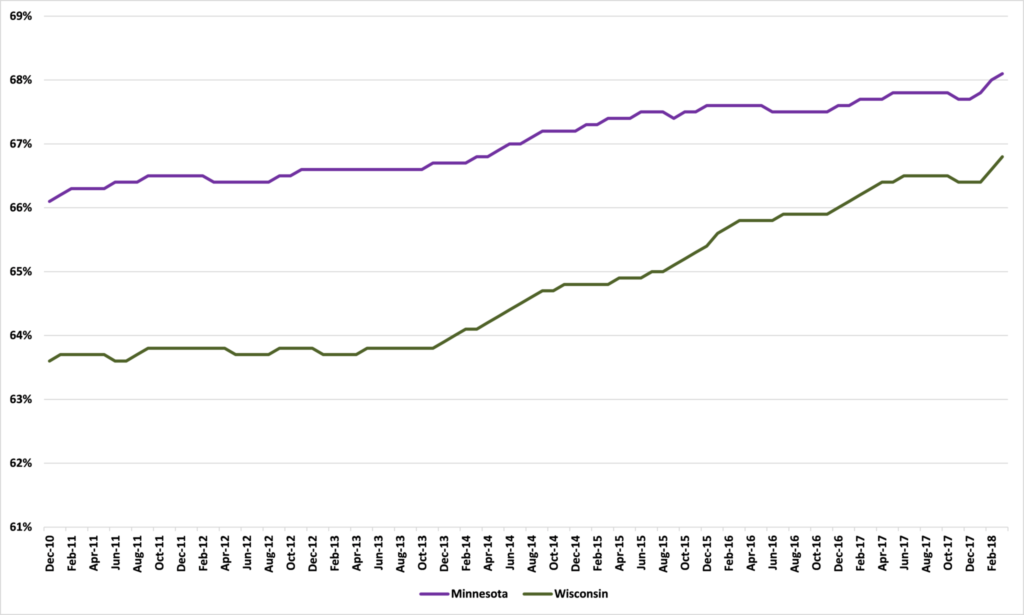The EPI does it again, distorting the records of Minnesota and Wisconsin on labor force participation
Over the last couple of days, I’ve written about a new report from the Economic Policy Institute which claims to show that Minnesota’s economy has performed much better since Mark Dayton became governor in January 2011 than Wisconsin’s has since Scott Walker did at the same time time. Looking at the data for GDP growth (Wisconsin’s has grown faster) and unemployment rates (Wisconsin’s has fallen faster and further), the EPI’s conclusion looks pretty far fetched. What if we look at labor force participation?
Since Governors Walker and Dayton took office, Wisconsin’s labor force participation rate has risen further and faster than Minnesota’s
The labor force participation rate measures the number of people in the labor force as a percentage of the civilian non-institutional population 16 years old and over. The EPI report covers the state’s rates on page 11.
Minnesota’s more expansive unemployment benefits and paid sick, family, and medical leave policies have likely played a role in the state maintaining higher rates of labor force participation—particularly for women—than Wisconsin has had since the recession.
Minnesota’s overall labor force participation rate of 71.2 percent was the second highest in the country in 2017, behind North Dakota. The Gopher State also had the highest primeage (workers ages 25–54) labor force participation rate in 2017 at 89.2 percent. Wisconsin’s overall and prime-age labor force participation rates were also near the top in the country, at 69.0 percent and 88.3 percent, respectively.
What the EPI doesn’t say is that Gov. Walker inherited a lower labor force participation rate than Gov. Dayton did. According to data from the Bureau of Labor Statistics, in December 2010, the last month before the two men took office, the rate in Wisconsin was 63.6%, 2.5 percentage points lower than the 66.1% rate Gov. Dayton inherited.
The EPI report fails to mention something else. Since Govs. Dayton and Walker took office, that gap has shrunk to 1.3 percentage points. As Figure 1 shows, while the labor force participation rate in Minnesota has risen by 2 percentage points under Gov. Dayton to 68.1% in March 2018, in Wisconsin, under Gov. Walker, it has risen by 3.2 percentage points, to 66.8%.
Figure 1 – Labor force participation rates, Minnesota and Wisconsin, December 2010 to March 2018, %

Source: Bureau of Labor Statistics
Given Wisconsin’s superior performance on this measure since January 2011, it obviously cannot be said, as the EPI does, that it is evidence that “Minnesota’s more expansive unemployment benefits and paid sick, family, and medical leave policies have likely played a role in the state maintaining higher rates of labor force participation—particularly for women—than Wisconsin has had since the recession.”
I’ll save time by repeating my conclusion from yesterday. Sadly, looking at the EPI’s presentation of the data on the state’s labor force participation rates only reinforces it.
It is fun to compare neighboring states. Sometimes, it can even be useful. But the sort of distortion the EPI is guilty of in this report helps nobody.
John Phelan is an economist at the Center of the American Experiment.